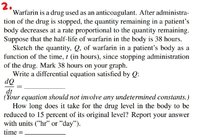ilovemathsomuch
New member
- Joined
- Feb 10, 2021
- Messages
- 3


Both of these seemed like half life questions so I used the differential equation dQ/dt=-kQ for each, solving for Q(t)=C*e^(-kt) (k as a constant representing half life of a substance). Despite this I can't even seem to get the one about writing the differential equation in question 2 right (shouldn't it be dQ/dt=-38Q ?). My answers for question one after solving for 0.34=1*e^(-k*580) were a) half life=1.86*10-3 and b) 444.4 days. Thanks in advance!
